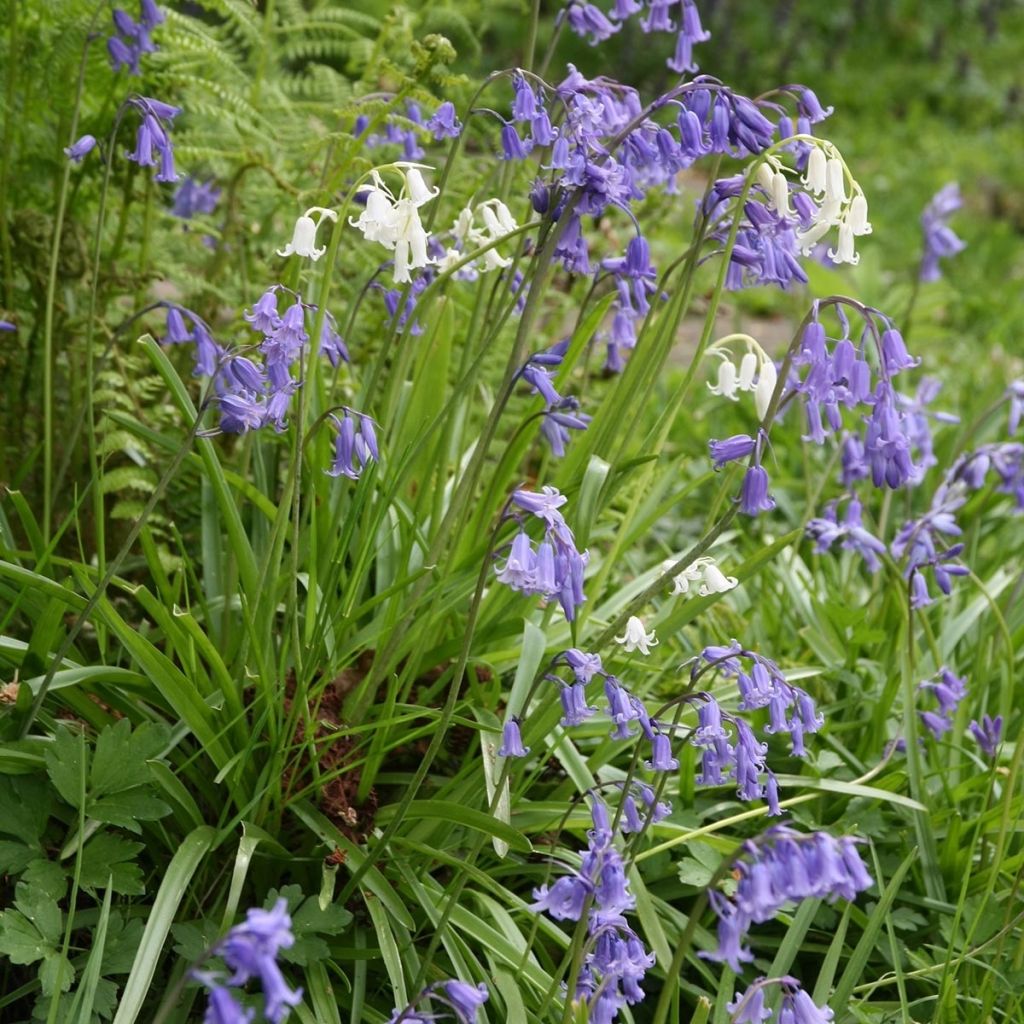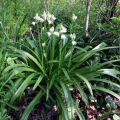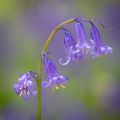

White-Blue Bluebell Collection
White-Blue Bluebell Collection
Hyacinthoides (Endymion) non-scripta
Common Bluebell, English Bluebell, British Bluebell, Wood Bell, Wild Hyacinth, Fairy Flower
This plant carries a 6 months recovery warranty
More information
We guarantee the quality of our plants for a full growing cycle, and will replace at our expense any plant that fails to recover under normal climatic and planting conditions.
From €5.90 for pickup delivery and €6.90 for home delivery
Express home delivery from €8.90.
Does this plant fit my garden?
Set up your Plantfit profile →
Collection items (20 plants)
Description
The White/Blue Bluebell Collection is a true treasure for shady areas of the garden. These bulbous plants, native to our cool undergrowth, offer a subtly fragrant flowering, which takes the form of beautifully curled, small, vivid blue-violet bells for the classic form, or pure white for the Alba form. The flower stalks tower above long, ribbon-like leaves gathered in tufts of cool, shiny green. Give this prolific plant some space, as it forms vast, beautifully blooming colonies in spring.
This collection consists of:
20 x bulbs of Hyacinthoides non-scripta, the wild bluebell with fresh blue flowers
20 x bulbs of Hyacinthoides non-scripta Alba, a selection of the wild bluebell with pure white flowers
The Hyacinthoides non-scripta, sometimes called scille nutans, is a perennial herbaceous plant with a bulb the size of a hazelnut. It belongs to the family Hyacinthaceae or Liliaceae depending on the classification. It is an endemic species to the Atlantic regions of Europe, almost absent elsewhere. Its distribution range extends from the north of the Iberian Peninsula to Belgium, passing through the British Isles. In France, it is native to the west, north of a Bordeaux-Dijon-Reims line. Today, it is threatened by the progressive destruction of its habitat and hybridisation with other species, and is protected in most of Western Europe. It is a plant that prefers bright semi-shade and clear undergrowth, and prefers deep, humus-rich, sandy-loamy soils with a slightly acidic tendency. Its presence is an indicator of ancient forest, qs is that of Lily of the Valley.
In spring, the plant develops a clump composed of 3 to 6 basal; narrow, linear leaves that are initially upright and then trail, about 20 cm (8in) long and 7 to 16 mm (0 to 1in) wide. From the center of the clump, a 30 to 40 cm (12 to 16in) tall flower stalk emerges in April-May. At its tip, there is a recurved, semi-pendant raceme or spike, which contains 5 to 12 flowers all facing the same side. Each pendant flower, 1.4 to 1.8 cm (1in) long, has the shape of a tube that widens into 6 curled lobes. This flowering is slightly fragrant. The foliage dries up in June, while the fruit-laden flower stalk persists until August.
The bulbs are packaged and labeled separately.
The Bluebell, which is now endangered, deserves to find refuge in our gardens. This mix, which combines blue and white forms, will offer the magnificent spectacle of its flowering, planted en masse in slightly wild areas of the garden, where it can spread freely. It will be perfect for bordering a shaded path, running along a wall that supports a fence, or beautifying the ground under a grove of deciduous bushes. It will accompany the flowering of euphorbias, highlight the blossoms of apple or cherry trees, and create a moving and magnificent spectacle at little cost. It can also be associated with Uvularia grandiflora with its lemon yellow flowers, Solomon's seals, and Lilies of the Valley... other robust and carefree woodland perennials.
Report an error about the product description
Plant habit
Flowering
Foliage
Botanical data
Hyacinthoides (Endymion)
non-scripta
Hyacinthaceae
Common Bluebell, English Bluebell, British Bluebell, Wood Bell, Wild Hyacinth, Fairy Flower
Western Europe
Planting and care
Plant your bluebells in clumps of 3 to 5, covered with 8 cm (3in) of good soil along the edges of lawns, flowerbeds, at the base of trees, spaced 10 cm (4in) apart. The bulbs will multiply easily and quickly once the plants are established. Prepare the soil well by loosening it and lightening it with a mixture of sand and leaf compost if necessary. Very chalky soil should be avoided, as well as very dry soil in summer.
Flowering Carpet Advice:
You can create beautiful flowered spaces around the house, in flowerbeds, around trees, or in wild spaces. It is an economical and sustainable solution, provided that a few principles are observed:
1) This is a variety that should be left in place, in well-drained but fairly moist soil.
2) Choose the varieties carefully according to the situation.
3) A period of rest is essential after flowering for the bulbs to replenish themselves. Allow the foliage to turn yellow and dry before cutting it.
4) Organic fertiliser should be spread once a year in autumn.
Planting period
Intended location
Care
This item has not been reviewed yet - be the first to leave a review about it.
Haven't found what you were looking for?
Hardiness is the lowest winter temperature a plant can endure without suffering serious damage or even dying. However, hardiness is affected by location (a sheltered area, such as a patio), protection (winter cover) and soil type (hardiness is improved by well-drained soil).

Photo Sharing Terms & Conditions
In order to encourage gardeners to interact and share their experiences, Promesse de fleurs offers various media enabling content to be uploaded onto its Site - in particular via the ‘Photo sharing’ module.
The User agrees to refrain from:
- Posting any content that is illegal, prejudicial, insulting, racist, inciteful to hatred, revisionist, contrary to public decency, that infringes on privacy or on the privacy rights of third parties, in particular the publicity rights of persons and goods, intellectual property rights, or the right to privacy.
- Submitting content on behalf of a third party;
- Impersonate the identity of a third party and/or publish any personal information about a third party;
In general, the User undertakes to refrain from any unethical behaviour.
All Content (in particular text, comments, files, images, photos, videos, creative works, etc.), which may be subject to property or intellectual property rights, image or other private rights, shall remain the property of the User, subject to the limited rights granted by the terms of the licence granted by Promesse de fleurs as stated below. Users are at liberty to publish or not to publish such Content on the Site, notably via the ‘Photo Sharing’ facility, and accept that this Content shall be made public and freely accessible, notably on the Internet.
Users further acknowledge, undertake to have ,and guarantee that they hold all necessary rights and permissions to publish such material on the Site, in particular with regard to the legislation in force pertaining to any privacy, property, intellectual property, image, or contractual rights, or rights of any other nature. By publishing such Content on the Site, Users acknowledge accepting full liability as publishers of the Content within the meaning of the law, and grant Promesse de fleurs, free of charge, an inclusive, worldwide licence for the said Content for the entire duration of its publication, including all reproduction, representation, up/downloading, displaying, performing, transmission, and storage rights.
Users also grant permission for their name to be linked to the Content and accept that this link may not always be made available.
By engaging in posting material, Users consent to their Content becoming automatically accessible on the Internet, in particular on other sites and/or blogs and/or web pages of the Promesse de fleurs site, including in particular social pages and the Promesse de fleurs catalogue.
Users may secure the removal of entrusted content free of charge by issuing a simple request via our contact form.
The flowering period indicated on our website applies to countries and regions located in USDA zone 8 (France, the United Kingdom, Ireland, the Netherlands, etc.)
It will vary according to where you live:
- In zones 9 to 10 (Italy, Spain, Greece, etc.), flowering will occur about 2 to 4 weeks earlier.
- In zones 6 to 7 (Germany, Poland, Slovenia, and lower mountainous regions), flowering will be delayed by 2 to 3 weeks.
- In zone 5 (Central Europe, Scandinavia), blooming will be delayed by 3 to 5 weeks.
In temperate climates, pruning of spring-flowering shrubs (forsythia, spireas, etc.) should be done just after flowering.
Pruning of summer-flowering shrubs (Indian Lilac, Perovskia, etc.) can be done in winter or spring.
In cold regions as well as with frost-sensitive plants, avoid pruning too early when severe frosts may still occur.
The planting period indicated on our website applies to countries and regions located in USDA zone 8 (France, United Kingdom, Ireland, Netherlands).
It will vary according to where you live:
- In Mediterranean zones (Marseille, Madrid, Milan, etc.), autumn and winter are the best planting periods.
- In continental zones (Strasbourg, Munich, Vienna, etc.), delay planting by 2 to 3 weeks in spring and bring it forward by 2 to 4 weeks in autumn.
- In mountainous regions (the Alps, Pyrenees, Carpathians, etc.), it is best to plant in late spring (May-June) or late summer (August-September).
The harvesting period indicated on our website applies to countries and regions in USDA zone 8 (France, England, Ireland, the Netherlands).
In colder areas (Scandinavia, Poland, Austria...) fruit and vegetable harvests are likely to be delayed by 3-4 weeks.
In warmer areas (Italy, Spain, Greece, etc.), harvesting will probably take place earlier, depending on weather conditions.
The sowing periods indicated on our website apply to countries and regions within USDA Zone 8 (France, UK, Ireland, Netherlands).
In colder areas (Scandinavia, Poland, Austria...), delay any outdoor sowing by 3-4 weeks, or sow under glass.
In warmer climes (Italy, Spain, Greece, etc.), bring outdoor sowing forward by a few weeks.





































